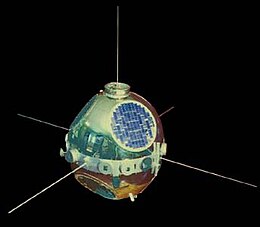SOLRAD 8
 | |
| Mission type | Solar science |
|---|---|
| Operator | NASA |
| COSPAR ID | 1965-093A |
| SATCATno. | 1738 |
| Mission duration | 58 years, 7 months and 23 days (in orbit) |
| Spacecraft properties | |
| Manufacturer | Naval Research Lab |
| Launch mass | 56.7 kilograms (125 lb) |
| Start of mission | |
| Launch date | November 19, 1965, 22:11:30UTC[1][2] |
| Rocket | Scout X-4 |
| Launch site | Wallops LA-3 |
| End of mission | |
| Last contact | August 1967 |
| Orbital parameters | |
| Reference system | Geocentric[3] |
| Regime | Circular orbit |
| Eccentricity | 0.01302 |
| Perigee altitude | 704 kilometers (437 mi) |
| Apogee altitude | 891 kilometers (554 mi) |
| Inclination | 59.7 degrees |
| Period | 100.8 minutes |
| Epoch | 19 November 1965, 04:48:00 UTC |
TheSOLRAD 8,Explorer 30orSE-Asatellite was one of theNASASOLRAD(Solar Radiation) program that began in 1960 to provide continuous coverage of solar radiation with a set of standardphotometers.SOLRAD 8 was aspin-stabilizedsatellite oriented with itsspin axisperpendicular to the sun-satellite line so that the 14 solar X-ray[4]and ultraviolet photometers[5]pointing radially outward from its equatorial belt viewed the sun on each revolution. Data were transmitted in real time by means of anFM/AMthe satellite's telemetry system and were recorded by the stations on theSpacecraft Tracking and Data Acquisition Network(STADAN) tracking network.[6]
Eclipse 1966[edit]
The satellite observed the solar eclipse on 20 May 1966.[7]This observation may have been the first observation of asolar eclipseby anartificial satellite.[7]
Mission[edit]
The satellite performed normally, except for the spin system,[8]which failed to maintain 60 rpm (at spin rates below 10 rpm data reduction became difficult). The spin rate gradually decreased to 4 rpm on September 12, 1966.[9]At that time, ground command succeeded in reactivating spinup to 78 rpm, which exhausted the gas supply. From this point, the spin rate gradually decreased to 10 rpm in August 1967, when data collection was substantially decreased.[10]
Experiment[edit]
Solar X-Ray and Ultraviolet Monitor[edit]
This experiment was designed to monitor solar X-ray and ultraviolet emissions with a set of standardized detectors so that the data could be compared directly with that produced by other experiments in the SOLRAD series. Eightion chambersand twoGeiger counterscovering the spectral regions from 0.5Ato 60 A and 1080 A to 1350 A were mounted perpendicular to the satellite spin axis. Analog outputs from the detectors were transmitted continuously on six IRIG telemetry channels. The experiment provided good data for all detectors from 27 November 1965 to 24 August 1967, with the following exceptions: (1) the Lyman- Alpha detector and the UV detectors were saturated for normal aspect angles, (2) the core memory failed at launch so that the data were collected in real-time telemetry only, and (3) a gradual decrease in spin rate caused the aspect angle to drift away from normal in the second year of operation.[11]
See also[edit]
References[edit]
![]() This article incorporatespublic domain materialfrom websites or documents of theNational Aeronautics and Space Administration.
This article incorporatespublic domain materialfrom websites or documents of theNational Aeronautics and Space Administration.
- ^"Solar-observing satellites".Rammb.cira.colostate.edu.Retrieved2014-05-27.
- ^"Launch Log".Jonathan's Space Report. 21 July 2021.Retrieved9 November2021.
- ^"Trajectory: Explorer 30 (Solrad 8) 1965-093A".NASA. 28 October 2021.Retrieved9 November2021.
 This article incorporates text from this source, which is in thepublic domain.
This article incorporates text from this source, which is in thepublic domain.
- ^ftp://ftp.ngdc.noaa.gov/STP/SOLAR_DATA/SATELLITE_ENVIRONMENT/XRAY_BGND/docs/solrad.txt
- ^"Solrad".Designation-systems.net.Retrieved2014-05-27.
- ^"Display: Explorer 30 (Solrad 8) 1965-093A".NASA. 28 October 2021.Retrieved9 November2021.
 This article incorporates text from this source, which is in thepublic domain.
This article incorporates text from this source, which is in thepublic domain.
- ^abLandini, M.; Russo, D.; Tagliaferri, G. L. (1966). "Solar Eclipse of 20 May 1966, observed by the Solrad 8 Satellite in X-ray and Ultraviolet Bands".Nature.211(5047): 393.Bibcode:1966Natur.211..393L.doi:10.1038/211393a0.S2CID4174785.
- ^"SOLRAD 8".Space Archaeology. Archived fromthe originalon 2017-12-08.Retrieved2014-05-27.
- ^National Research Council (U.S.). Space Science Board, COSPAR (1967).United States Space Science Program: Report to COSPAR.National Academies. p.47.
- ^"NASA:SP-4312 Dreams, Hopes, Realities-Chapter 1:Goddard's First Forty: The Quest to Learn".History.nasa.gov. 1957-10-04.Retrieved2014-05-27.
- ^"Experiment: Solar X-Ray and Ultraviolet Monitor".NASA. 28 October 2021.Retrieved9 November2021.
 This article incorporates text from this source, which is in thepublic domain.
This article incorporates text from this source, which is in thepublic domain.
External links[edit]

